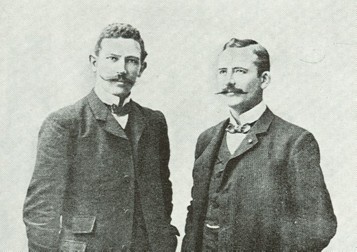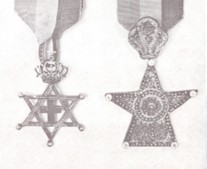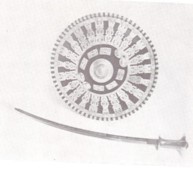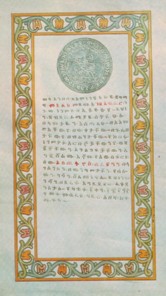Résumé
to the book
Life and work of brothers Seljan (Zivot i djelo brace Seljan)
by Aleksandra Sanja Lazarevic,
Etnografski muzej,
Zagreb, 1977.
Two Croatian explorers, brothers Mirko and Stevo Seljan, both born in Karlovac (Mirko was born on April the 5th 1871, and Stevo on August the 19th 1875), went as very young men at the beginning of 1899 to Ethiopia, a country which had attracted them ever since Mirko's visit to Czarist Russia. After several months' exhausting and perilous journey which included crossing the Somali desert, they arrived at Harrar, the eastern fortress of Ethiopia. After that everything went as if according to a carefully designed plan. At the court they were given an audience by the Emperor Menelik IT. He put them in charge of the training of 300 men, and they soon turned these into an efficient royal body-guard. As a reward for training his soldiers the Emperor promoted them to the rank of officer.

In Addis Ababa they met diplomatic and military representatives of European countries which were increasingly interested in Ethiopia, especially after the Italian-Ethiopian War of 1895-96. The Seljans very quickly became friendly with the Russians and French, who were the most numerous among the Europeans in Ethiopian capital. They took part in Emperor Menelik's ambitious undertakings. Negus Menelik, surrounded by European advisors who helped him to attain a balance with the powerful Rases, surprisingly fast conquered part after part of vast, until then unconquered, lands of south equatorial Ethiopia populated by archaic negroid tribes.
Ethiopian
Star and The Solomon's Knight Cross,
decorations awarded by Emperor Menelik II to brothers Seljan
Newly aded provinces inhabited by mutinous populations had to be brought under Negus' rule, and this task was usually entrusted to governors appointed by the Emperor.
A gift of Emperor Menelik II to Mirko
Seljan, with inscription on gold plated sword:
Ethiopia raises its hands to God (in Amharic)
The Seljans soon also became governors of several southern provinces, and from their residences, first of which was Uba, they executed the Emperor's orders at the same time commencing their researches of a geographic and ethnographic character. The result of these explorations was a geographic map drawn by hand "according to nature", by Mirko Seljan, and signed in Uba on November the 15th 1900. They also collected ethnographic material which was later donated to the then National Museum of Zagreb. This valuable cultural inventory is today in the possesion of the Ethnographic Museum of Zagreb. They founded their headquarters a military settlement named after them Seljanville, in the far, south of the country, in the province of Turkana behind Lake Rudolf. In everchanging conditions the settlement decayed, and today only ruins remain.
A charter bestowed by Emperor Menelik
II to brothers Seljan
with inscription in Amharic
They performed the duty of governors for more then two years, and then "anxious for civilization and homesick" they went back to Europe. For their merits they were gifted by the Emperor with presents (a silk tunic, a steel sabre in velvet sheath and shield ornamented with black velvet and silver), and also decorated with high Ethiopian decorations (the Solomon's Knight Cross and the Ethiopian Star). They were granted a title of »Viscount of Turkana« after the province which they explored.
The archival inheritance left by them, a geographic map of southern Ethiopia and a collection of ethnographic and cultural-historical material, are the nucleus from which it is possible to evaluate their share in the ethnographic and geographic sciences, which is the main intention of this study.
After analysing manuscripts and other documents connected with the Ethiopian phase of their exploratory work, and after comparing ethnographic texts in these manuscripts with the scientific results published in »Altvolker Sud - Athiopiens« by Frobenius - Institut Frarikfurt/Main, 1959, the author considers that the ethnographic notes written by the Seljan brothers can stand comparison in the light of today's science.
A similar comparative analysis was carried out on the whole cultural inventory which was donated by the Seljans to the National Museum of Zagreb, today in the possession of the Ethnographic Museum of Zagreb.
The geographic map of southern Ethiopia sketched "according to nature" by Mirko Seljan in his residence in Uba, in 1900, is in the author's opinion probably the first complete survey of that part of Ethiopia. Leontiev's, Chedeuvre's, McDonald's, Bottega's and other expeditions explored and mapped with less detail only a smaller part of the area. The provinces and tribes drawn in the map represent even in the light of today's science an early and valuable account of the tribal situation in this part of Ethiopia.
They left Ethiopia at the beginning of 1902.
In 1903 they went to Brasil in' South America, where they established the Mision Cientifica Croata Mirko y Stevo Seljan, an enterprise through which they negotiated numerous business transactions with South-American states and Business corporations. From May 1903 until the end of October 1905 they travelled across, and undertook numerous explorations in Brazil and Paraguay.
The Brazilian govern'ment entrusted them with the task of exploring the possibility of using the rivers as navigable waterway communications in an east-west course in order to connect relatively densely populated districts near the Atlantic coast with spacious, scarcely populated and very secluded areas around river Parana, and through it with areas in the Brazilian state of Mato Grosso.
In Paraguay they explored the river basin of the rivers Parana and Paraguay. They also carefully explored the Salto Grande waterfalls on the Paranapanema river, the El Salto del Guayra waterfalls on the Parana river and cataracts on the Iguazu river. They published the results of their explorations together with drawings and photographs in a book called El Salto del Guayra, which was printed in Spanish and French in Buenos Aires in 1905. In the name of the Croatian Scientific Mission in 1906 they signed a contract with the Brazilian Federal State of Mato Grosso. Under this contract they were obliged to clear land for future communication between Cuyaba in the state of Mato Grosso and Santarem in the state of Para on the river Amazon. After all preparations, including the providing of complete and very expensive equipment for the expedition, a revolution broke out in the state of Mato Grosso. The complete equipment of the expedition, together with plans was stranded, and also the money that was invested in it.
During these expeditions they studied the life and culture of the Indian aboriginals, they collected ethnographic material to send later to the National Museum of Zagreb. This is today in possession of the Ethnographic Museum of Zagreb.
During the 1907-1911 period the Seljans developed intensive educational and cultural activity among Croatian and other Slavic immigrants in South America. Simultaneously they explored the delta of the Amazon. They crossed the Andes frgm Argentina to Chile several times. In the northeni part of Chile they examined dry, spacious areas of Chilean nitre and surveyed the layers of nitre and borax.
In Bolivia they visited the monuments of the old Inca culture.
In 1911 they signed a contract with the Peruvian government about planning and building the road which was to connect the highlands of Peru with wide territories of eastern Peru along the riverAmazon. Mirko Seljan worked on the realization of this plan until his death in 1913. After making a contract with the Peruvian government they went to the United States where they entered into business with some American industrialists who were interested in projects in Peru. The Americans took upon themselves to finance and equip the expedition. When in the United States, from November 1911 until July 1912, they had visited numerous Croatian settlements and held lectures about their travels for the general public. Often, the lectures finished with concerts, as the Seljan brothers were excellent musicians. Mirko played the violin and Stevo the pipe. Every time they found themselves among Croatian and other Slavic emigrants, they worked with great enthusiasm on their collecting so that they could preserve their national identity even in a foreign country.
On returning to Peru they set up the expedition. After leaving Cerro de Pasco, they went towards the upper part of the Huallaga river. Stevo returned to Chicago in order to be a connecting link between the expedition, Peruvian government and American bankers. It was Mirko's last expedition. He explored the project for the future road and blazed the trail - piquades in uninvestigated parts of Peru. From Cerro de Pasco he descended to Huanuco, across Tingo Maria to Pachiza. Afterwards he went upstream the Huayabamba river, the left affluent of the Huallaga river, to Payaten, the last civilised settlement above the Huayabamba river. After resting, the relatively ill-equiped expedition passed through uncleared virgin forests in a north-western direction with the intention of crossing Central Peruvian Cordilleras and descending to the upper Maranon, near the village of Cajamarquillea. The expedition disappeared in this totally unknown area. On March 30, 1913 Mirko wrote his last letter to his mother in Karlovac, to brother Stevo and to his partners in Chicago.
No one knows just how Mirko died but, it is thought that the date was April or May 1913. The American engineer Patrick O'Higgins who took part in the expedition in the name of the American Syndicate died with him.
After Mirko's death Stevo explored the mineral wealth of Central and South America. From 1917 until his death in 1936 he lived near the town of Ouro Preto in the Brazilian state of Minas Gerais.
In spite of all troubles which followed them during their expeditions, the Seljan brothers left numerous manuscripts and written material which is still unpublished. This material and the cultural inventory donated to the Zagreb National Museum is valuable material for geographic and ethnographic researches.
The present book is based on research into this material.
Misionar na Gornjem Nilu, Damir Zoric
Los hermanos Seljan, exploradores en África y Sudamérica, Lelio Janin, Buenos Aires


